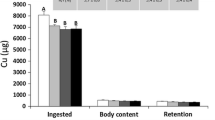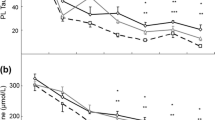Summary
Background
Fibers and potassium (K) organic salts in plant foods are liable to affect Ca and Mg balance at digestive and renal levels, respectively. K organic salts could counteract the acidifying effects of western diets and consequences of excess NaCl.
Aim of the study
To study this question, male rats were adapted to a basal acidifying low-K (LK) diet, or to diets supplemented with a fiber mix (LK/F), or K citrate (HK) or both (HK/F).
Results
HK and HK/F diets displayed a marked alkalinizing effect in urine and promoted citraturia, but this effect was not modulated by fibers. The effect of fibers on Ca digestive absorption was more potent than K citrate effect on Ca renal excretion. In contrast, K citrate effect on kidney Mg excretion was more effective than that of fibers on Mg digestive absorption, a maximal effect on Mg balance was observed in rats fed the HK/F diet. Digestive fermentations in rats fed the LK/F diet were characterized by high-propionic acid fermentations and succinate accumulation. In rats adapted to the HK/F diet, K citrate supplementation depressed succinate and increased butyrate concentrations.
Conclusion
Organic anions arising from digestive fermentations seem to be not directly involved in the alkalinizing effects of plant foods. Fibers and organic K salts exert distinct effects on Ca and Mg metabolism, but with interesting interactions as to Mg balance, digestive fermentations and urine pH.


Similar content being viewed by others
Abbreviations
- SCFA:
-
short-chain fatty acid
References
Lock K, Pomerleau J, Causer L, Altmann DR, McKee M (2005) The global burden of disease attribuable to low consumption of fruit and vegetables: implications for the global strategy of diet. Bull World Health Organis 83:100–108
Alonso A, de la Fuenta C, Martin- Arnaud AM, de Irala J, Martinez JA, Martinez-Gonzalez MA (2004) Fruit and vegetable consumption is inversely associated with blood pressure in a Mediterranean population with a high vegetable-fat intake: the Seguimiento Universidad de Navarra (SUN) Study. Br J Nutr 92:311–319
Meschi T, Maggiore M, Fiaccadori E, Schianchi T, Bosi S, Adorni G, Rodolo E, Guerra A, Allegri F, Novarini A, Borghis L (2004) The effect of fruits and vegetables on urinary stone risk factors. Kidney Int 66:2402–2410
Young DB, Ma G (1999) Vascular protective effects of potassium. Semin Nephrol 19:477–486
Tucker KL, Hannan MT, Chen H, Cupples A, Wilson PWF, Kiel DP (1999) Potassium, magnesium, and fruit and vegetable intake are associated with greater bone mineral density in elderly men and women. Am J Clin Nutr 6:727–736
Sellmeyer DE, Stone KL, Sebastian A, Cummings SR (2001) A high ratio of dietary animal to vegetable protein increase the rate of bone loss and the risk of fracture in postmenopausal woman. Am J Clin Nutr 73:118–122
Cummings JH, Macfarlane GT (1997) Role of intestinal bacteria in nutrient metabolism. J Parenter Enteral Nutr 21:357–365
Rémésy C, Levrat M-A, Gamet L, Demigné C (1993) Cecal fermentations in rats fed oligosaccharides (inulin) are modulated by dietary calcium level. Am J Physiol 264:G855–G862
Aprikian O, Duclos V, Guyot S, Besson C, Manach C, Bernalier A, Morand C, Rémésy C, Demigné C (2003) Apple pectin and a polyphenol-rich apple concentrate are more effective together than separately on cecal fermentations and plasma lipids in rat. J Nutr 133:1860–1865
Younes H, Coudray C, Bellanger J, Demigne C, Rayssiguier Y, Rémésy C (2001) Effects of two fermentable carbohydrates (inulin and resistant starch) and their combination on calcium and magnesium balance in rats. Brit J Nutr 86:479–485
Coudray C, Feuillet-Coudray C, Tressol JC, Gueux E, Thien S, Jaffrelo L, Mazur A, Rayssiguier Y (2004) Stimulatory effect of inulin on intestinal absorption of calcium and magnesium in rats is modulated by dietary calcium intakes. Eur J Nutr 44:293–302
Scharrer E, Lutz T (1990) Effects of short chain fatty acids and K on absorption of magnesium and other cations by the colon and caecum. Z Ernahrungswiss 29:162–168
Trinidad PT , Wolever TMS, Thompson LU (1999) Effects of calcium concentration, acetate, and propionate on calcium absorption in the human distal colon. Nutrition 15:529–533
Sellin JH (1999) SCFAs: the enigma of weak electrolyte transport in the colon. News Physiol Sci 14:58–64
Kunzelmann K, Mall M (2002) Electrolyte transport in the mammalian colon: mechanisms and implications for disease. Physiol Rev 82:245–289
Rémésy C, Demigné C, Aufrère J (1978) Inter-organ relationships between glucose, lactate and amino acids in rats fed on high-carbohydrate or high-protein diets. Biochem J 170:321–329
Sabboh H, Horcajada M-N, Coxam V, Tressol J-C, Besson C, Rémésy C, Demigné C (2005) Effect of potassium salts in rats adpated to an acidogenic high-sulfur amino acid diet. Br J Nutr 94:192–197
Rémésy C, Demigné C (1974) Determination of volatile fatty acids in plasma after ethanolic extraction. Biochem J 141:85–91
Scholz-Ahrens KE, Schrezenmeir J (2002) Inulin, oligofructose and mineral metabolism – experimental data and mechanism. Br J Nutr 87:S179–S186
Naaeder SB, Evans DF, Archampong EQ (1998) Effect of acute dietary supplementation on colonic pH in healthy volunteers. West Afr J Med 17:153–156
Demigné C, Sabboh H, Puel C, Rémésy C, Coxam V (2004) Organic anions and potassium salts in nutrition and metabolism. Nutr Res Rev 17:249–258
Vidyasagar S, Barmeyer C, Geibel J, Binder HJ, Rajendran VM (2005) Role of short-chain fatty acids in colonic HCO3 secretion. Am J Physiol 288:G1217–G1226
Mortensen PB, Clausen MR (1996) Short-chain fatty acids in the human colon: relation to gastrointestinal health and disease. Scand J Gastroenterol 216:132–148
Welbourne TC, Joshi S (1990) Interorgan glutamine metabolism during acidosis. J Parenter Enteral Nutr 14:77S–85S
Pajor AM (1999) Citrate transport by the kidney and intestine. Semin Nephrol 19:195–200
Epstein W (2003) The role and regulation of potassium in bacteria. Prog Nucleic Acid Res Mol Biol 75:293–320
Curthoys NP (2001) Role of mitochondrial glutaminase in rat renal glutamine metabolism. J Nutr 131:2491S–2495S
Greger JL (1999) Nondigestible carbohydrates and mineral bioavailability. J Nutr 129:1434S–1435S
Coudray C, Demigné C, Rayssiguier Y (2003) Effect of dietary fibers on magnesium absorption in animals and humans. J Nutr 233:1–4
Dai LJ, Friedman PA, Quamme GA (1997) Acid-base changes alter Mg2+ uptake in mouse distal convoluted tubule cells. Am J Physiol 272:F759–F766
Quamme GA (1997) Renal magnesium handling: new insights in understanding old problems. Kidney Int 52:1180–1195
Tosukhowong P, Borvonpadungkitti S, Prasongwatana V, Tungsanga K, Jutuporn S, Dissayabutr T, Reungjui S, Sriboonlue P, Tosukhowong P (2002) Urinary citrate excretion in patients with renal stone: roles of leucocytes ATP citrate lyase activity and potassium salts therapy. Clin Chim Acta 325:71–78
Melnick JZ, Srere PA, Elshourbagy NA, Moe OW, Preisig PA, Alpern RJ (1996) Adenosine triphosphate citrate lyase mediates hypocitraturia in rats. J Clin Invest 98:2381–2387
Hering-Smith KS, Gambala CT, Hamm LL (2002) Citrate and succinate transport in proximal tubule cells. Am J Physiol 278:F492–F498
Ritz E, Maluche HH, Krempien B, Mehls O (1981) Calcium metabolism in renal failure. In: Bronner F, Coburn JW (eds) Text-book of disorders of mineral metabolism, Vol. III, Academic Press, Inc. (London), pp 158–160
New SA (2003) Intake of fruits and vegetables: implications for bone health. Proc Nutr Soc 62:889–899
Acknowledgement
Supported by a grant from the «Agence Pour la Recherche et l’Information en Fruits et Légumes frais» (APRIFEL, Paris, France).
Author information
Authors and Affiliations
Corresponding author
Rights and permissions
About this article
Cite this article
Sabboh, H., Besson, C., Tressol, JC. et al. Organic potassium salts or fibers effects on mineral balance and digestive fermentations in rats adapted to an acidogenic diet. Eur J Nutr 45, 342–348 (2006). https://doi.org/10.1007/s00394-006-0604-0
Received:
Accepted:
Published:
Issue Date:
DOI: https://doi.org/10.1007/s00394-006-0604-0




